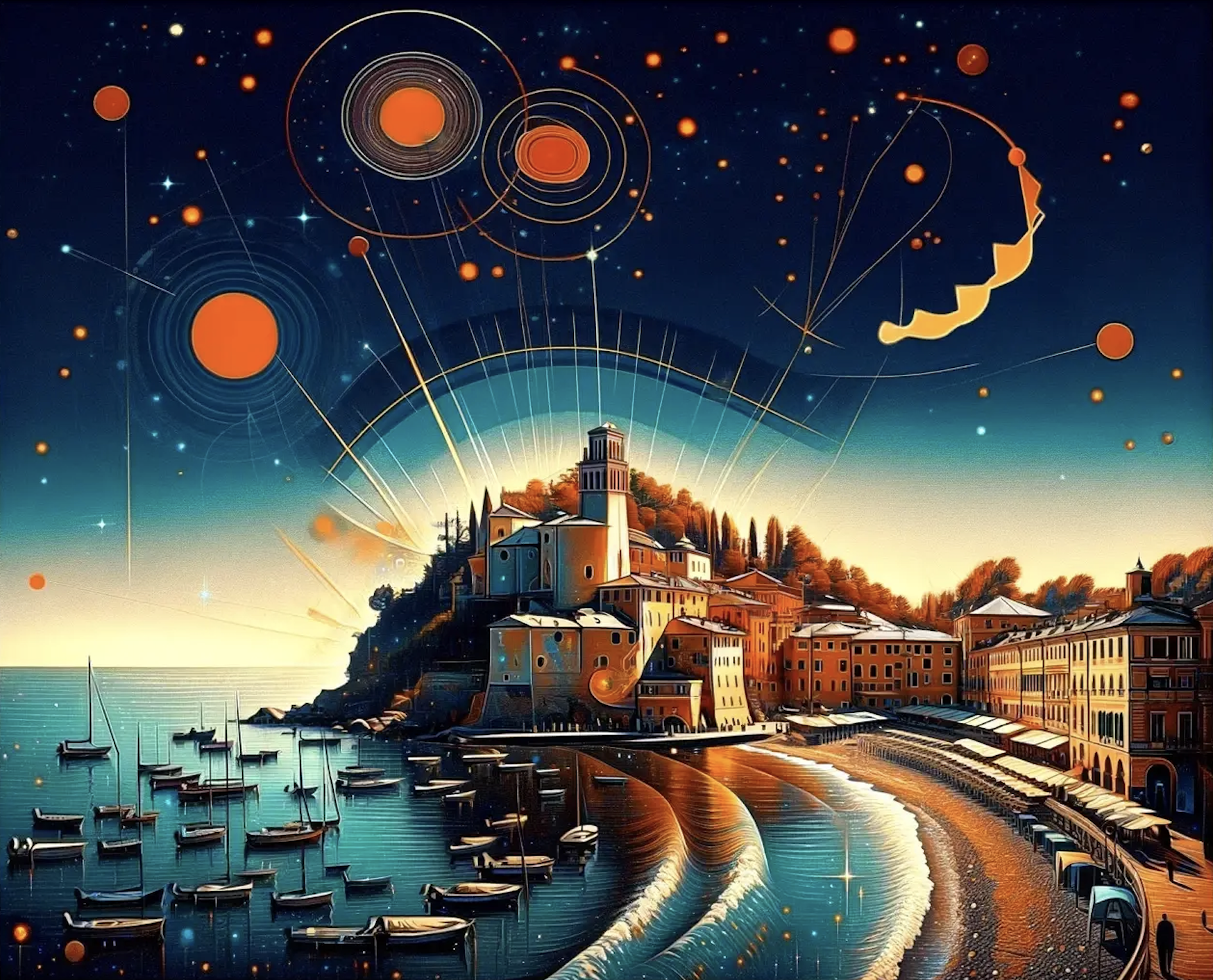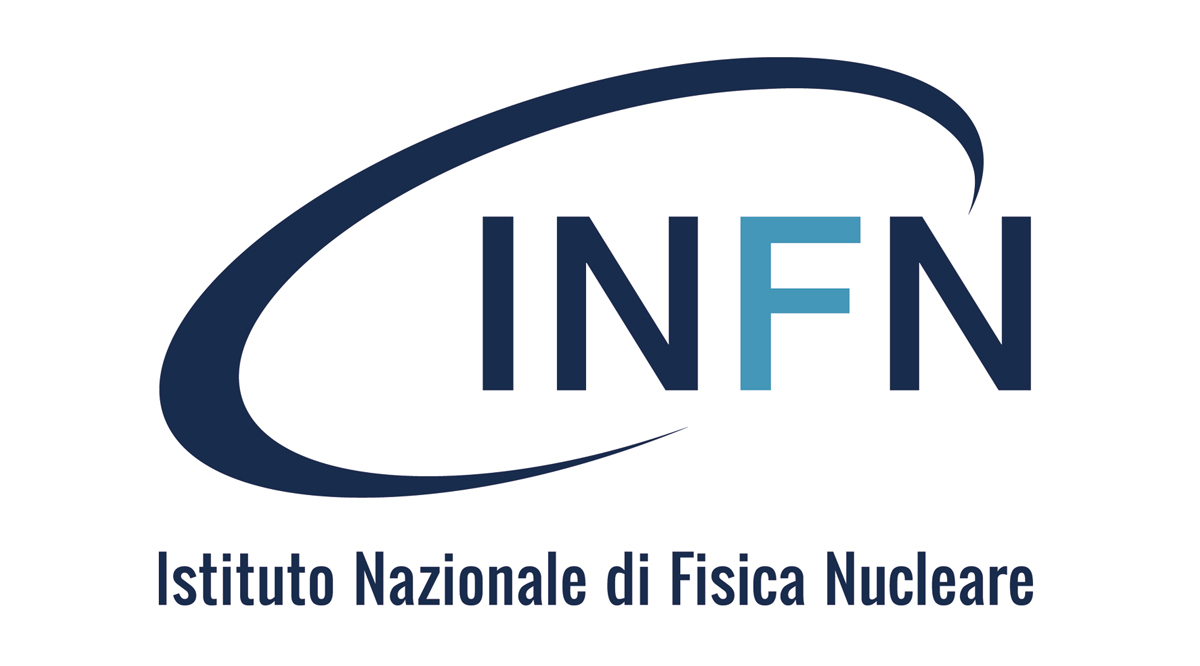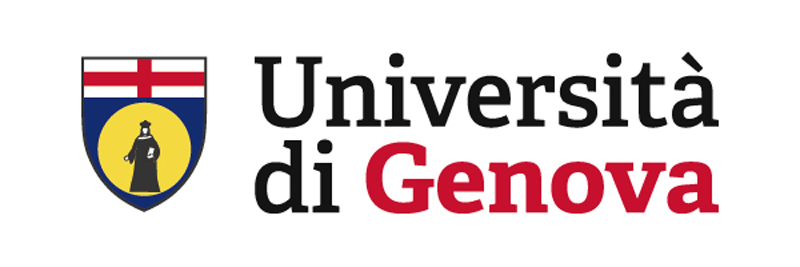Understanding the Galaxy/Matter Connection in the Era of Large Surveys
Sestri Levante
A PRIN-MIUR 2017 legacy workshop.
The workshop aims to summarize the findings of the PRIN-MUR-2017 project, "From Darklight to Dark Matter: Understanding the Galaxy/Matter Connection to Measure the Universe," and to discuss current and future developments in view of the vast array of incoming data from ongoing observational campaigns, fostering discussions on their implications and potential avenues for research.
Our objective is to strengthen connections between participants of the PRIN project and a broader community of established and potential collaborators. Together, we aim to stimulate new scientific endeavors and maximize the utility of forthcoming data.
To view the complete program, go to Timetable > Detailed View.
If you plan to give a talk, you can volunteer and submit your abstract in the Call for Abstracts. Talks will be scheduled once the number of participants has been confirmed.
Due to unforeseen bureaucratic reasons, we have been requested to change the venue. The new location, Hotel Grande Albergo, is still in Sestri Levante, closer to the beach, and just as nice as the original one. Please check the "Venue and Accommodation" section for details.
 |
-
-
09:50
→
10:00
Welcome Address 10m
- 10:00 → 10:20
-
10:20
→
10:40
RU2 Report 20mSpeaker: Enzo Franco Branchini (Istituto Nazionale di Fisica Nucleare)
- 10:40 → 11:00
-
11:00
→
11:35
Coffe break 35m
-
11:35
→
12:00
The peculiar velocity and momentum density bispectra 25m
I examine galaxy peculiar velocities as a cosmological probe and compute their kernels in standard perturbation theory up to second order. With these, I construct the peculiar velocity power spectrum and bispectrum at tree level. I find agreement with the literature for the former and I derive the expression for the latter for the first time. As a byproduct, I also derive the bispectrum of the so-called momentum density, i.e. the density-weighted peculiar velocity field. Focussing on the two new bispectra, I compare them to the well-studied bispectrum of galaxy clustering. I find that, in general, both of them can provide constraints on the growth rate of cosmic structures tighter than those obtained with the galaxy clustering bispectrum, making them a compelling cosmological probe in themselves and, all the more so, to complement standard galaxy clustering analyses.
Speaker: Prof. Stefano Camera (Università degli Studi di Torino & INFN Torino) -
12:00
→
12:25
Is it possible to measure the observer's velocity from spectroscopic redshift surveys? 25m
The peculiar velocity of the observer induces a dipolar signature on galaxy density maps derived from redshift surveys. Following Elkhashab Porciani & Bertacca paper (in prep) [see also Elkhashab, Porciani and Bertacca, Mon. Not. Roy. Astron. Soc. 509, no.2, 1626-1645 (2021), arXiv:2108.13424], in this talk, I focus on assessing the impact of this signature on the multipoles of the observed power spectrum, unveiling an oscillatory signal at ultra-large scales dubbed the "Finger-Of-The-Observer" (FOTO) effect.
To validate our analytical findings, we numerically measure the FOTO signal in the power spectrum monopole using mock catalogues built using the LIGER method. Our results demonstrate the detectability of the FOTO signal, achieving signal-to-noise ratios ranging from approximately 4 to 7 standard deviations for surveys that cover 36% to 100% of the sky. In the second part I explore the feasibility of eliminating the FOTO signal through a radial redshift transformation. In Elkhashab Porciani & Bertacca paper, we find that this correction fails to eliminate the observer velocity imprint due to the persistence of relativistic aberration and magnification effects post-correction. This transformation leads to signal enhancement for surveys with redshifts z > 0.5. Finally, we propose a novel method to extract information from the FOTO signal. By measuring the power spectrum monopole from artificially boosted catalogues, attainable through simple redshift transformations, we are able to determine the velocity of the observer or extract cosmological parameters such as the matter density parameter and the equation of state of dark energy.Speaker: Daniele Bertacca (Istituto Nazionale di Fisica Nucleare) -
12:25
→
12:50
Understanding Projection Effects for Cosmological Posterior Distributions 25m
I will discuss how to understand and cope with projection effects concerning posterior distributions from cosmological experiments, with a particular focus on LSS surveys.
Speaker: Marco Raveri (Istituto Nazionale di Fisica Nucleare) -
12:50
→
14:20
Lunch 1h 30m
-
14:20
→
14:40
Detecting Relativistic Doppler in Galaxy Clustering via Multi-tracing a Single Galaxy Population 20m
The description of gravity, i.e. the theory of general relativity, plays a crucial role in our understanding of the universe. However, confirmations of the validity of this theory on cosmological scales have hitherto eluded us. In this context, the detection of relativistic Doppler via galaxy power spectrum measurements could further confirm the validity of general relativity at scales very far from the strong-gravity-field regime, where instead it has been tested with exquisite accuracy. The Doppler term acts as an imaginary correction in the relation between the galaxy density contrast and that of matter, which mostly affects the large-scales usually plagued by cosmic variance. Cross-correlation power spectra seem to be much more promising than auto-correlation ones, due to the presence of the relativistic effect in a non-vanishing imaginary term that might be relevant even at intermediate scales. Moreover, relativistic Doppler is sample-dependent, so different galaxy populations display different contributions in their power spectra. In the search for the optimal galaxy samples to achieve a detection of the relativistic term, we can split a galaxy population according to luminosity, and even perform a multi-tracer analysis with auto-correlations of the two sub-samples and their cross-power spectrum. We are thus able to devise a technique enjoying multi-tracer benefits out of a single dataset and obtain a detection well above 5σ.
Speaker: Federico Montano (Istituto Nazionale di Fisica Nucleare) -
14:40
→
15:00
Nonlinear galaxy clustering in massive neutrino cosmologies 20m
Upcoming data from galaxy surveys has the potential to yield a detection of the sum of the neutrino masses. Therefore, state-of-the-art models for full-shape analyses of correlation functions need a complete validation in the context of massive neutrino cosmologies.
We perform a joint analysis of the power spectrum and bispectrum using a suite of mock galaxy catalogs built upon N-body simulations with massive neutrinos. The accuracy, constraining power, and degeneracies of the 1-loop EFT-based model, along with the role of the priors, are assessed.
To the same end, we investigate the potential ambiguities in the generalization of the Kaiser formula, as well as the issue of velocity bias, in the presence of massive neutrinos. These are relevant for an accurate modeling of the anisotropic clustering.Speaker: Francesco Verdiani (SISSA) -
15:00
→
15:25
Dark matter distribution in galaxy clusters from X-ray/SZ data 25m
Galaxy clusters are dark-matter-dominated systems enclosed in a volume that is a high-density microcosm of the rest of the universe. I will present the most recent results on the distribution of their gravitating and baryonic mass obtained from our XMM-Newton Multi-year Heritage and Large Programmes (CHEX-MATE, X-COP) complemented with Planck maps, highlighting the role of X-ray and SZ data in resolving the astrophysics of the most massive collapsed halos in the universe and in studying the interplay between the hot plasma and dark matter. I will discuss the role of non-thermal pressure support as a major source of the difference between the hydrostatic and the total ``true'' halo mass. These studies will pave the way for using the next generation of X-ray observatories, like XRISM and NewAthena, to construct a consistent picture of the formation and composition in mass and energy of galaxy clusters.
Speaker: Dr Stefano Ettori (INAF-OAS Bologna) -
15:25
→
16:15
Coffe break 50m
-
16:15
→
17:30
Discussion Session. Building upon Prin2017 results: what next. 1h 15m
-
17:30
→
20:00
Free Time 2h 30m
-
20:00
→
23:00
Social Dinner at Sciamadda dei Vinaccieri
-
09:50
→
10:00
-
-
09:00
→
09:25
Cosmological results from one year of DESI observations 25m
In its first year of observations the Dark Energy Spectroscopic Instrument (DESI) has built the largest map of galaxy redshifts to date, I will present the first set of cosmological results, coming from measurements of the baryonic acoustic oscillations (BAO) characteristic scale. The analysis of the full shape of the power spectrum is still ongoing but there is a chance that the results will public by the date of the meeting, in which case I will include them in my presentation.
Speaker: Davide Bianchi -
09:25
→
09:50
Towards a full modelling of the 3PCF at the BAO scales 25m
Higher-order correlation functions (such as the three-point correlation function, 3PCF) will play a crucial role in future cosmological surveys since they complement the information provided by the (more commonly used) lower-order correlation functions (e.g., the two-point correlation function, 2PCF) allowing a significant gain in the cosmological information extracted from Large Scale Structure.
However, one problem relies upon the fact that producing models for the 3PCF is challenging both theoretically, but also computationally, so this has currently become a major bottleneck preventing the possibility of massive 3PCF analyses.In this talk, I will present a new work in which we developed a Machine-Learning emulator to produce models of the anisotropic 3PCF of matter at BAO scales. We use this model to explore the potential constraints we can have on cosmological parameters with future surveys, and the ability to robustly detect the BAO peak in the 3PCF. I also present a new emulator for the total and no-wiggle power spectrum, which is capable of reproducing the original with an accuracy <1% at all scales. This work is a pilot project that opens the possibility of a full emulation of 3PCF models.
Speaker: Michele Moresco (Universita' di Bologna) -
09:50
→
10:10
Pioneering Advancements in Modelling the Galaxy Three-Point Correlation Function 20m
For galaxy clustering, constraining cosmological parameters using the three-point correlation function has historically been hindered by the computational cost of modelling. Here, we introduce a new emulator developed as part of an Euclid Preparation Key Project, which significantly accelerates MCMC evaluations. For the first time in a simulation study, we present constraints on cosmological parameters by combining two- and three-point statistics. Additionally, we discuss ongoing activities related to modelling the 3PCF in the highly non-linear regime, exploring pioneering models for galaxy biasing up to next-to-leading order perturbative models.
Speaker: Massimo Guidi (University of Bologna) -
10:10
→
10:30
PBJ: a fast pipeline for the analysis of Stage-IV galaxy clustering data 20m
Ongoing spectroscopic Stage-IV galaxy surveys, such as Euclid and DESI, are starting to deliver high precision data that will allow to map the Universe over unprecedented volume and measure cosmological observables with high precision, with the ultimate goal of investigating the dark sector. Inferring cosmological parameters from such measurements requires fast and flexible analysis pipelines and a tight control over systematics, both theoretical and observational. Additionally, maximising information extracted from the data by including both nonlinear scales and higher order statistics is crucial to ensure the success of these cosmological experiments. I will present recent developments in PBJ, a Bayesian inference pipeline for the joint analysis of the power spectrum and bispectrum, an describe results from Stage-III data from the BOSS survey. The pipeline features the state-of-the art EFTofLSS model for the nonlinear galaxy power spectrum and a tree-level model for the bispectrum, as well as the possibility to include data from the post-reconstruction power spectrum, and several sampler to explore the parameter space. I will also give an overview of the usecases within the Euclid collaboration, which include updated forecasts, investigation of projection effects in the posterior distributions for extended cosmological models, the analysis of beyond-LCDM cosmologies and studies of systematics impact on the cosmological constraints.
Speaker: Chiara Moretti (SISSA) -
10:30
→
11:10
Coffe break 40m
-
11:10
→
11:30
HoDpipe: re-creating a realistic Universe 20m
In the era of Stage IV galaxy surveys, model testing and validation with numerical simulations is crucial to obtain accurate and unbiased estimates of the cosmological parameters. To this end, the generation of realistic galaxy mock catalogs that faithfully reproduce the measurable properties of the observed sky is of utter importance.
In this talk, I will present HoDpipe, a new tool to generate quick galaxy mocks replicating a number of properties given as inputs.
HoDpipe is fast and flexible: it implements different Halo Occupation Distribution (HOD) models, halo density profiles, assembly and velocity biases and can predict galaxy and clustering properties, redshift distributions and correlation functions.
HoDpipe can be used to generate galaxy mocks to test theoretical models, as a benchmark for analytical covariance calculations and as a validation tool for approximate methods.Speaker: Gabriele Parimbelli -
11:30
→
11:50
Studying the large-scale structure of the Universe with radio data 20m
Galaxy surveys can be photometric (big volumes but also big redshift errors) or spectroscopic (accurate redshifts but small volumes). The technique that goes beyond this compromise is hydrogen intensity mapping (HI IM). Indeed, radio telescopes tomographically characterise the Universe, detecting the redshifted 21 cm radiation emitted by cosmic neutral hydrogen: both large areas and spectroscopic information are ensured. In this talk, I will present the HI IM technique and discuss its challenges and opportunities. In particular, I will show how we address the (in)famous contaminant separation problem with first-of-their-kind data from the MeerKAT telescope single-dish observations. Within the MeerKLASS collaboration, we started an effort to test and optimise the available contaminant cleaning methods directly on data. We assess their effectiveness by measuring the expected cross-correlation signal with an overlapping galaxy dataset. I'll present our results, which are encouraging and relevant for the forthcoming direct detection of the IM signal with MeerKAT. Our ongoing work demonstrates that a radio array operating as a collection of independent telescopes can probe the IM cosmological signal, marking a milestone for the cosmology science case with the entire SKA Observatory (which the MeerKAT dishes will be part of).
Speaker: Isabella Paola Carucci (INAF - Trieste) -
11:50
→
12:10
HI intensity mapping with MeerKAT 20m
Neutral hydrogen (HI) intensity mapping is arising as a novel probe of the Large Scale Structure of the Universe, and the MeerKAT radiotelescope is being used in the so called single-dish mode to test this technique as a precursor of the SKAO. These observations are characterised by a variety of systematics and astrophysical foregrounds that are much more intense than the cosmological signal and therefore limited the possibility to detect it. I will present the results of the analysis of the data taken during the MeerKAT 2021 observing season and I will show how, by means of internal cross-correlation, it is possible to mitigate the impact of systematics and reach a detection of the HI auto-power spectrum.
Speaker: Matilde Barberi Squarotti (Università degli Studi di Milano) -
12:10
→
12:30
The cross-correlation between CIB and galaxy clustering 20m
Understanding the intricate relationship between star-formation rates from Comic Infrared
Background(CIB) and other large scale structure tracers holds key insights into the evolving
cosmic landscape. By cross-correlating the CIB data and other large-scale structure (i.e. CMB
lensing and galaxy clustering), we can unravel the underlying dynamics and give better
constrains on the models as well as retrieve the primordial information hidden behind the
interference of these tracers. With the galaxy clustering data from Euclid in the near future,
we can unravel the information hidden in the redshift distribution of star forming rate by its
cross-correlation with Cosmic Infrared Background data from Planck. Thus, a better
tomographic constrain on the halo model can be achieved.Speaker: Jiakang Han -
12:30
→
14:00
Lunch 1h 30m
-
14:00
→
14:25
Controlling systematics in spectroscopci galaxy clustering 25m
I will show recent updates on the Euclid strategy to control systematics of the spectroscopic sample used for galaxy clustering.
Speaker: Pierluigi Monaco (Istituto Nazionale di Fisica Nucleare) -
14:25
→
14:50
Characterizing selection effects and Data systematics in Stage IV spectroscopic surveys 25mSpeakers: Antonio Farina (Istituto Nazionale di Fisica Nucleare), Edoardo Maragliano (Istituto Nazionale di Fisica Nucleare, UniGe)
-
14:50
→
15:10
On the optimal extraction of the Alcock Paczynski signal from voids 20m
Cosmic voids, large under-dense regions in the Universe, serve as promising laboratories for extracting cosmological information. They offer opportunities to explore deviations from $\Lambda 𝐶𝐷𝑀$ and provide insights into dark energy and modification of gravity. Upcoming surveys like Euclid will enable detailed void analyses, allowing access to a huge number of voids. Voids' significance lies in their spherically symmetric property when stacked, becoming standard spheres. However, observationally, they exhibit two types of distortions crucial for extracting cosmological information: redshift-space distortions (RSD), caused by galaxy velocities, and geometrical distortions, arising from the use of incorrect cosmological models when converting observed redshifts into distances (Alcock-Paczynski test). Current RSD models are insufficient for smaller voids. A new technique, utilizing a reconstruction method based on the Zel’dovich approximation, extends analyses to smaller voids and enhances the precision of parameter constraints.
Speaker: Giulia Degni (Università Roma Tre) -
15:10
→
15:30
Mapping the Universe with neural nets 20mSpeaker: Punyakoti Ganeshaiah Veena
-
15:30
→
16:15
Coffe break 45m
-
16:15
→
17:00
Wrapping up 45m
-
09:00
→
09:25




